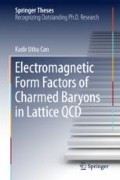Abstract
This chapter is devoted to making the reader familiar with the ideas underlying the QCD and its formalism. We briefly discuss the advent of the color quantum number, which is a unique feature and centerpiece of strong interactions. In what follows, QCD is presented formally as a quantum field theory, where we discuss its energy scale-dependent characteristics and how it is related to the formation of hadrons. Finally, by following the early experimental developments, we give a historical account of the evidence for the hadron structure and sketch the simple formalism that is commonly used to study it in a theoretical approach.
Access this chapter
Tax calculation will be finalised at checkout
Purchases are for personal use only
References
C. Patrignani et al., Review of particle physics. Chin. Phys. C40(10), 100001 (2016), https://doi.org/10.1088/1674-1137/40/10/100001
O.W. Greenberg, Spin and unitary-spin independence in a paraquark model of baryons and mesons. Phys. Rev. Lett. 13, 598–602 (1964), http://link.aps.org/doi/10.1103/PhysRevLett.13.598
Y. Nambu, A systematics of hadrons in subnuclear physics, in Preludes in Theoretical Physics in Honor of V. F. Weisskopf (1966), p. 133
M.Y. Han, Y. Nambu, Three-triplet model with double \({\text{SU}}(3)\) symmetry. Phys. Rev. 139, B1006–B1010 (1965), http://link.aps.org/doi/10.1103/PhysRev.139.B1006
L. Montanet et al., Review of particle properties. Phys. Rev. D 50, 1173–1814 (1994), http://link.aps.org/doi/10.1103/PhysRevD.50.1173
L.D. Faddeev, V.N. Popov, Feynman diagrams for the yang-mills field. Phys. Lett. B 25(1), 29–30 (1967). ISSN 0370-2693, http://www.sciencedirect.com/science/article/pii/0370269367900676
T.-P. Cheng, L.-F. Li, Gauge Theory of Elementary Particle Physics (Clarendon Press, Oxford, 1984)
S. Weinberg, The Quantum Theory of Fields. Vol. 2: Modern Applications (Cambridge University Press, Cambridge, 2013). ISBN 9781139632478, 9780521670548, 9780521550024
G. Hooft, Renormalization of massless yang-mills fields. Nucl. Phys. B 33(1), 173–199 (1971a)
G. Hooft, Renormalizable lagrangians for massive yang-mills fields. Nucl. Phys. B 35(1), 167–188 (1971b)
I.J.R. Aitchison, AJG Hey, Gauge Theories in Particle Physics: A Practical Introduction, 4th edn. (CRC Press, Boca Raton, FL, 2013), https://cds.cern.ch/record/1507184
J. Frenkel, J.C. Taylor, Asymptotic freedom in the axial and coulomb gauges. Nucl. Phys. B 109(3), 439–451 (1976). ISSN 0550-3213, http://www.sciencedirect.com/science/article/pii/0550321376902443
I.B. Khriplovich, Green’s functions in theories with non-abelian gauge group. Sov. J. Nucl. Phys. 10, 235–242 (1969). Yad. Fiz.10,409 (1969)
D.J. Gross, F. Wilczek, Ultraviolet behavior of non-abelian gauge theories. Phys. Rev. Lett. 30, 1343–1346 (1973), http://link.aps.org/doi/10.1103/PhysRevLett.30.1343
H.D. Politzer, Reliable perturbative results for strong interactions? Phys. Rev. Lett. 30, 1346–1349 (1973), http://link.aps.org/doi/10.1103/PhysRevLett.30.1346
M. Gell-Mann, F.E. Low, Quantum electrodynamics at small distances. Phys. Rev. 95, 1300–1312 (1954), http://link.aps.org/doi/10.1103/PhysRev.95.1300
C.G. Callan, Broken scale invariance in scalar field theory. Phys. Rev. D 2, 1541–1547 (1970), http://link.aps.org/doi/10.1103/PhysRevD.2.1541
K. Symanzik, Small distance behaviour in field theory and power counting. Comm. Math. Phys. 18(3), 227–246 (1970), http://projecteuclid.org/euclid.cmp/1103842537
M. Czakon, The four-loop QCD beta-function and anomalous dimensions. Nucl. Phys. B 710, 485–498 (2005), https://doi.org/10.1016/j.nuclphysb.2005.01.012
T. van Ritbergen, J.A.M. Vermaseren, S.A. Larin, The four loop beta function in quantum chromodynamics. Phys. Lett. B 400, 379–384 (1997), https://doi.org/10.1016/S0370-2693(97)00370-5
S. Bethke, The 2009 world average of \(\alpha \) s. Eur. Phys. J. C 64(4), 689–703 (2009). ISSN 1434-6052, http://dx.doi.org/10.1140/epjc/s10052-009-1173-1
G. Arnison et al., Observation of jets in high transverse energy events at the cern proton antiproton collider. Phys. Lett. B 123(1), 115–122 (1983). ISSN 0370-2693, http://www.sciencedirect.com/science/article/pii/037026938390970X
G. Arnison et al., Associated production of an isolated, large-transverse-momentum lepton (electron or muon), and two jets at the cern pp collider. Phys. Lett. B 147(6), 493–508 (1984). ISSN 0370-2693, http://www.sciencedirect.com/science/article/pii/0370269384914102
P. Bagnaia et al., Measurement of very large transverse momentum jet production at the cern pp collider. Phys. Lett. B 138(5), 430–440 (1984). ISSN 0370-2693, http://www.sciencedirect.com/science/article/pii/037026938491935X
G.S. Bali, QCD forces and heavy quark bound states. Phys. Rept. 343, 1–136 (2001), https://doi.org/10.1016/S0370-1573(00)00079-X
I. Estermann, O. Stern, Über die magnetische ablenkung von wasserstoffmolekülen und das magnetische moment des protons. ii. Zeitschrift für Physik 85(1), 17–24 (1933). ISSN 0044-3328, http://dx.doi.org/10.1007/BF01330774
R. Frisch, O. Stern, Über die magnetische ablenkung von wasserstoffmolekülen und das magnetische moment des protons. i. Zeitschrift für Physik 85(1), 4–16 (1933). ISSN 0044-3328, http://dx.doi.org/10.1007/BF01330773
R.W. McAllister, R. Hofstadter, Elastic scattering of 188-mev electrons from the proton and the alpha particle. Phys. Rev. 102, 851–856 (1956), http://link.aps.org/doi/10.1103/PhysRev.102.851
E.M. Riordan, The Discovery of quarks. Science 256, 1287–1293 (1992), https://doi.org/10.1126/science.256.5061.1287
J.D. Bjorken, Asymptotic sum rules at infinite momentum. Phys. Rev. 179, 1547–1553 (1969), http://link.aps.org/doi/10.1103/PhysRev.179.1547
R.P. Feynman, Photon-Hadron Interactions (WA Benjamin Inc., Reading, MA, 1972)
R.P. Feynman, Very high-energy collisions of hadrons. Phys. Rev. Lett. 23, 1415–1417 (1969), http://link.aps.org/doi/10.1103/PhysRevLett.23.1415
M. Gell-Mann, A schematic model of baryons and mesons. Phys. Lett. 8(3), 214–215 (1964). ISSN 0031-9163, http://www.sciencedirect.com/science/article/pii/S0031916364920013
G. Zweig, An SU(3) model for strong interaction symmetry and its breaking. Version 2, in Developments in the quark theory of hadrons, 1964–1978, vol. 1, ed. by D.B. Lichtenberg, S.P. Rosen (Hadronic Press, Inc., Nonantum, MA, 1980), pp. 22–101, http://inspirehep.net/record/4674/files/cern-th-412.pdf
J. Arrington, P.G. Blunden, W. Melnitchouk, Review of two-photon exchange in electron scattering. Prog. Part. Nucl. Phys. 66(4), 782–833 (2011). ISSN 0146-6410, http://www.sciencedirect.com/science/article/pii/S0146641011000962
M.N. Rosenbluth, High energy elastic scattering of electrons on protons. Phys. Rev. 79, 615–619 (1950), http://link.aps.org/doi/10.1103/PhysRev.79.615
R.G. Sachs, High-energy behavior of nucleon electromagnetic form factors. Phys. Rev. 126, 2256–2260 (1962), http://link.aps.org/doi/10.1103/PhysRev.126.2256
Author information
Authors and Affiliations
Corresponding author
Rights and permissions
Copyright information
© 2018 Springer Nature Singapore Pte Ltd.
About this chapter
Cite this chapter
Can, K.U. (2018). Quantum Chromodynamics. In: Electromagnetic Form Factors of Charmed Baryons in Lattice QCD . Springer Theses. Springer, Singapore. https://doi.org/10.1007/978-981-10-8995-4_2
Download citation
DOI: https://doi.org/10.1007/978-981-10-8995-4_2
Published:
Publisher Name: Springer, Singapore
Print ISBN: 978-981-10-8994-7
Online ISBN: 978-981-10-8995-4
eBook Packages: Physics and AstronomyPhysics and Astronomy (R0)

